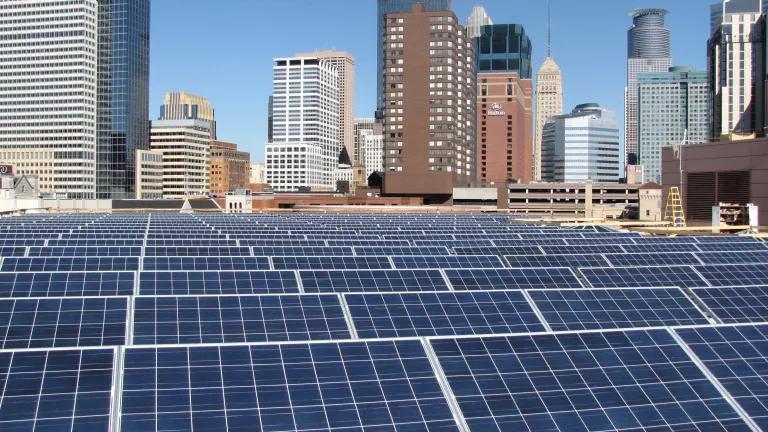Healthy, Clean Energy Buildings Take Center Stage in 2021
Replacing building systems that burn fossil fuels on-site with appliances powered by clean electricity is a key strategy to combat the climate crisis.

Part of NRDC’s Year-End Series Reviewing 2021 Climate & Clean Energy Developments
Clean and healthy buildings surged forward as a policy priority in 2021. Buildings—our homes and places of work—are responsible for a quarter of the U.S.’s climate-busting greenhouse gas emissions. Replacing building systems that burn fossil fuels on-site with appliances powered by clean electricity is a key strategy to combat the climate crisis. As policymakers recognized how important our homes and places of work will be to meeting climate goals, communities across the country saw unprecedented policy action and market growth in the right direction: clean, healthy, affordable homes for all.
Energy and Housing Justice
To prevent future harm and proactively benefit those who have suffered disproportionate historic burdens, frontline communities should be centered in the policy-making process. Decision makers also need to ensure energy and housing justice principles are foundational elements of policy. 2021 saw many examples of how this commitment to energy and housing justice can result in stronger policies for all.
- The cities of Boston and Denver undertook thorough community engagement processes to design each of their landmark existing buildings laws. Both laws were subsequently passed with unanimous support from City Council, built broad consensus across industry and stakeholders, and will result in marked emission reductions while protecting and enhancing the health and economic welfare of the city’s most vulnerable populations.
- The city of Los Angeles recently introduced a motion that centers the scope of building decarbonization on key energy and housing justice principles, to prevent exacerbation of Los Angeles’ housing and homelessness crisis and ensure the benefits of decarbonization prioritize the city’s low-income renters.
- State governments also took significant steps to prioritize equity in their 2021 building electrification policies. California’s new Building Initiative for Low-Emissions Development program (BUILD) will provide funds to new affordable housing projects. And, as other states are following California’s building electrification lead, they too are centering equity.
- The landmark building electrification law passed this year in Colorado requires that at least 20 percent of the new fund support low income and disproportionately impacted communities. The Colorado law also has strong workforce protection standards that will help ensure new building electrification jobs are family-sustaining.
For the transition to healthy, electric buildings to be truly equitable, clean energy itself—not just the appliances that use it—must remain affordable. Electric rates are too often used to pay for the damages caused by fossil fuels, like wildfires. This ironically hinders the transition away from polluting energy sources, locking in climate, pollution, and cost impacts. To accelerate the transition to clean energy in buildings, transportation, and industry, the cleaner energy source must also be the most affordable. This issue rose in prominence in 2021, and we expect much of our 2022 work will continue to address it.
Increased Investment from Cities, States, and the Federal Government Lead to Visible Results
In California, where much of this movement began, 54 cities and counties now have passed ordinances that strongly encourage or require that new buildings be all-electric. The California Energy Commission followed suit in August by adopting a first-in-the-nation new statewide building code with a strong incentive for efficient all-electric new construction. Elsewhere, the City of Seattle also adopted electrification requirements for new large multifamily buildings, with its King County and Eugene, Oregon neighbors following closely behind. This is all in addition to Denver and Boston’s trailblazing policies for existing buildings.
New laws and regulations designed to support healthy, efficient, electric buildings became a reality at the state level too. Colorado enacted a landmark package of laws, including a performance standard for large commercial buildings, the nation’s first emission reduction glidepath for gas use in buildings, and utility funding to reduce the cost of new efficient electric technologies. Washington and New York state invested in all-electric technology too. Illinois, Minnesota, and California significantly expanded how much of their existing energy efficiency funds will be spent on helping people transition to healthy all-electric equipment, with New Jersey following suit.
The federal government is doing its part too: Congress included more than $5 billion for building energy efficiency in the Infrastructure Investment Job Act signed into law by President Biden on November 6, and the Build Back Better bill now under consideration in the Senate would expand funding for energy efficiency and electrification in buildings, including significant investments in affordable housing.
President Biden’s Federal Sustainability Plan includes ambitious goals for Federal buildings including energy efficiency and electrification. The U.S. Department of Energy (DOE) launched its Energy, Emissions, and Equity Initiative (E3) to advance the research, development, and national deployment of clean heating and cooling systems. The U.S. Environmental Protection Agency (EPA) phased out polluting gas appliances from its Most Efficient appliance specification and is proposing a similar move with its regular specification for water heaters, recognizing that fossil fuel appliances (which are four to five times less efficient than modern heat pumps) have no place in an Energy Star program meant to recognize the top-performing products for energy efficiency and clean air.
And all this policy support is working! A highly anticipated new “plug-in” water heater model designed to make it easier to electrify existing homes hit the market this year. Shipments of high efficiency electric space heating equipment have doubled since 2000, and are now on par with gas furnace shipments. Manufacturers see where the market is headed—highly efficient heat pumps, powered by 100 percent clean electricity—and are ready to continue meeting the challenge in every corner of the country.
States Planning for a Just and Managed Transition, but Much Work Remains
As we shift more of our energy use away from fossil gas and toward clean electricity, we must also plan for the retirement of the gas system that served our energy needs in the past. Planning for a managed transition off of the gas system is the only way to ensure continued safety, affordability, and economic welfare for all current gas customers and workers. So, in this year of unprecedented investment in a healthier, cleaner building stock, the number of states planning for a smaller gas system doubled, from four to eight.
2021 was a momentous year in the transition to healthy, clean buildings for all. Significant policy commitments came all the way from city halls to the halls of Congress. We saw shifts in the market momentum toward clean energy-powered appliances and many more states taking on all parts of the transition away from polluting fossil gas. This is still only the beginning—we must ensure all people living in the U.S. have access to the affordable, healthy homes they need—and we at NRDC look forward to continuing this work in 2022.




